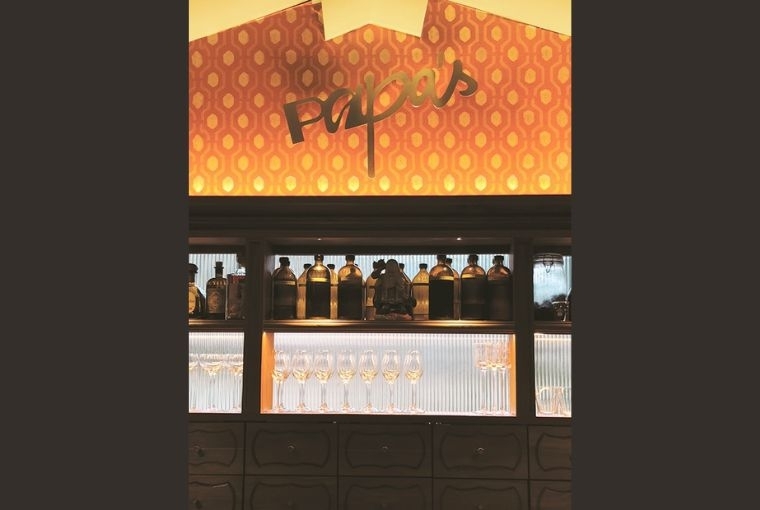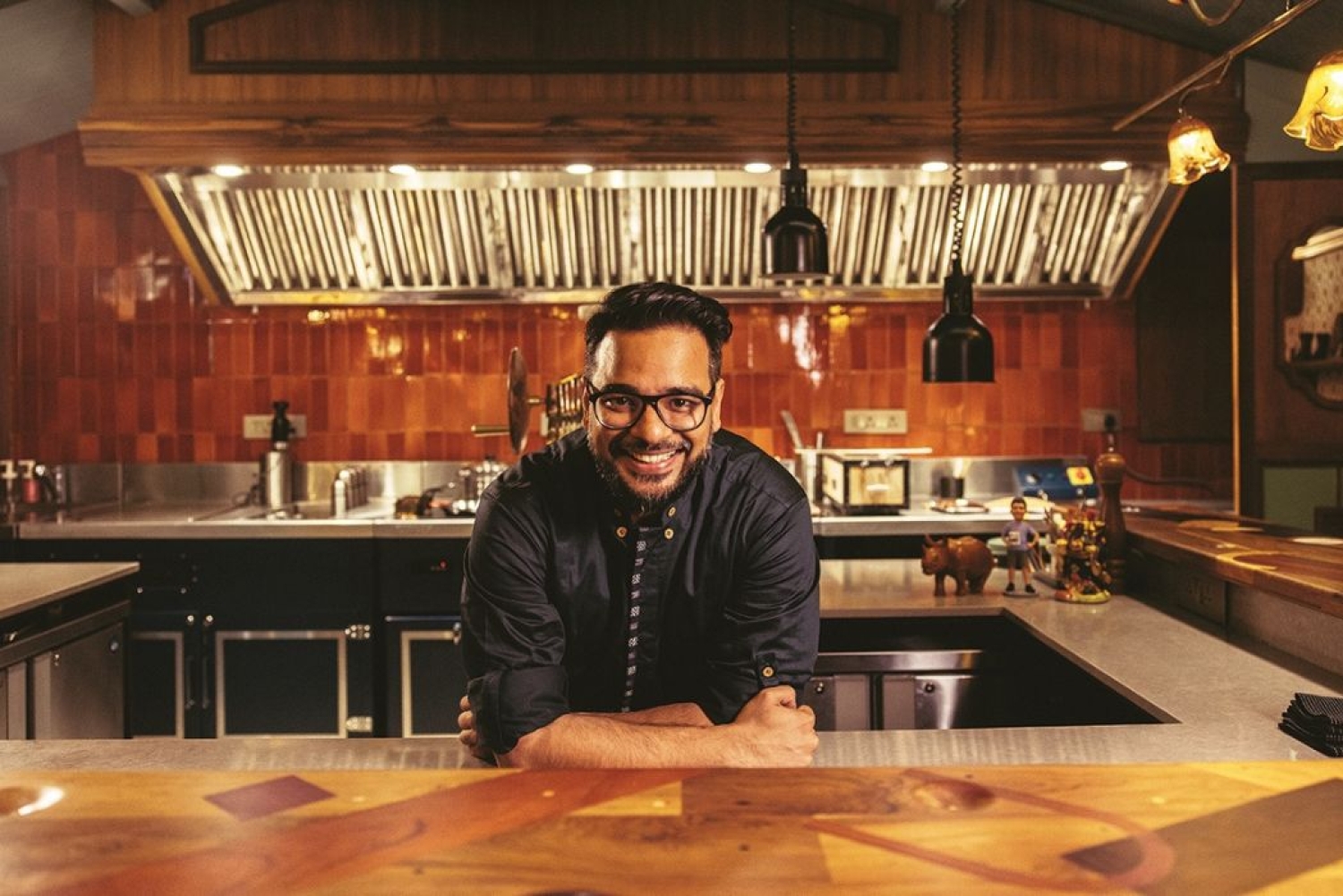

In the case of modern Indian fine dining, the landscape is ripe with reservations. What was once a rare experience in one corner of the capital city has now evolved into something far more expansive. From the Himalayas to the outskirts of Tipeshwar and all of the major cities, diners from the subcontinent are queuing up for high-end culinary experiences.
Where meals are traditionally centered around generous thalis, shared curries and buffet tables overflowing with choice, tasting menus offer the opposite: small, intentional portions, plated with precision and paced dish by dish. Diners used to abundance and sharing, find this shift both novel and intimate — less about feeding the masses and more about following the chef’s expression, one bite at a time.
For the latest chapter in Chef Hussain Shahzad’s story, the old and new come together where the warmth of a Desi communal table meets the precision of a modern tasting menu. Hussain and his merry cast of team members serve this juxtaposition at the table at Papa’s, the latest addition to his growing portfolio as Executive Chef at Hunger Inc. Hospitality.
Celebrated for bringing together India’s culinary heritage with modern-day knife-skills, the group currently operates five inspirational concepts — from the acclaimed Bombay Canteen (upscale Indian fare) and O Pedro (Goan coastal cooking), to the cult sandwich shop Veronica’s and the nostalgic-yet-modern Bombay Sweet Shop. Each offering a new turn of the page for Hussain and — up until now — each sharing the concept of a? la carte dining and volume service.
Papa’s however is far more intimate. A personal journey comes full circle. Like many of his peers from the Indian chef community, Hussain’s restaurant career started at a 5-star hotel. While mastering the Oberoi Centre of Learning and Development, one of the world’s highest accreditations within the industry, he explored the world via pages of recipe books. Through one of these collections — a gift from his mother — Hussain was compelled to send a cross-Atlantic email requesting an internship. In the matter of days — three, he notes — the restaurant replied saying they do not offer internships but how about a job?
‘I didn’t expect it and I didn’t know if I wanted to leave the Oberoi at that point. It’s the world I knew. I felt comfortable,’ he shrugs. But through conversations with his mother, Hussain made the choice to pack his bags and head for America. He would be working at Eleven Madison Park (EMP).
From his trial days in the 3-Star Michelin kitchen to making a beef steak for the legendary, late Chef James Kent, Hussain worked his way from an entry-level cook to mastering every station at the institutional restaurant. ‘It was then that I started to realise it was much more than about the food. It was about how the diner felt when they left.’
Around the same time, Hussain met with the late Chef Floyd Cardoz, the head chef patron at EMP’s NYC neighbour, Tabla. Accredited for introducing modern Indian fine dining to America, Chef Floyd was starting a same-same-but-different approach back home in India. And he wanted Hussain to come and be a part of that movement with him.
But it was a moment outside the kitchen that sparked the next chapter. ‘I was eating this salad at Betony,’ Hussain describes, ‘and it was full of greens and grains that are native to India. But we’d never think to serve it this way, let alone charge for it. It sparked something.’ Soon after, he returned to India and joined the team at The Bombay Canteen, where he began weaving technique with memory, curiosity with masala. And it’s that same combination he brings upstairs at Papa’s, in a space that feels entirely his own.
‘To us at Papa’s, over the last year, I feel people have left feeling really happy. We’ve had a lot of fun,’ says Hussain. ‘That’s what I see Papa’s as — a place where you can come, have a fun night, forget your life for the few hours that you’re here with us and pick it up when you leave these two doors. That’s the feeling we want you to have.’
That sense of playfulness and emotional release unfolds gradually, not just in subtle gestures, but in moments of grandeur that sneak up. The way a tipsy buzz builds while sipping cocktails at a friend’s dinner party. It all feels casual at first, even cozy, but as the night rolls on and the dishes and drinks begin to flow, the vibe loosens up and the lines, well, they are gone.
An arrival at Papa’s begins at the vividly painted façade of Veronica’s, the fast-casual sandwich shop it sits above. Guests navigate a maze of tightly packed tables and the ever-present queue before slipping behind the counter and climbing the staircase. At the top, a glowing neon sign marks the transition: ‘Papa’s’ now stamped over the name of its former occupant, Jude’s Bakery.
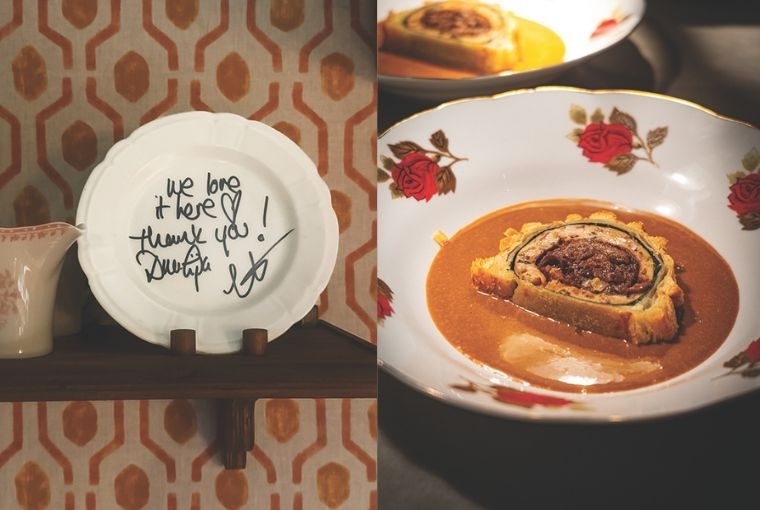
Left: Photography Gauri Sarin
Step through the wooden windowpane door and the raucous energy below dissolves, replaced by the lived-in charm of what could be a retro Bandra home. Complete with vintage ceramics, warm chairs and fabric covered walls and framed whimsical artwork like the restaurant’s beloved cartoon cat, Nosy Lucy. At the center of it all sits Hussain’s signature twelve seat counter.
The evening starts off like a dinner party where you’ve invited several friends who do not know each other yet. The traditional host stand at the start of the experience is replaced by something far more familiar — members of the team from general manager, Madhusudhan Kashyap, to bartender Harish Subramanian and Chef Hussain himself, make their way from diner to diner welcoming them in, almost like they’ve come home.
And like many homes pan-India, a dinner party at Papa’s starts with a drink.
Evidence of a bar-kitchen crossover comes through in both their ‘classics remixed,’, as well as the ‘no rules rules’ section of the cocktail menu. The former features drinks like the undoubtedly complex boulevardier whose strawberry garnish devilishly leads you to think it will be sweet. It is not. As boozy as it should be, the drink takes on a new level of familiar depth — even if it may not be obvious to all — with the combination of strawberry and balsamic vinegar.
Although the cocktail program is sophisticated, Chef’s promise to have fun shines through in the latter part of the cocktail menu with original drinks concocted with help from the chefs.
Papa’s Hut is an almost translucent pour that, upon first sip, gives you a lingering hint of oregano. Call it curiosity or craving for more of the umami, the second sip reveals almost a sweet but savory finish. You could compare it to tomato sauce and you would be right. Here, house batched marinara sauce is cooked into its comfort- ing form, frozen and strained. Mix it with Ketel One and you have yourself Papa’s version of a Bloody Mary. As the title of the menu suggests, it rules.
Of course no cocktail hour would be complete without snacks. While more traditional dining would have you seated for your amuse bouche, Hussain and his team would rather you find joy in the three opening bites wherever you happen to be, drink in hand.
Casual in delivery but refined in their plating, the trio is seemingly expected if one is accustomed to a Western tasting menu. Foie gras crusted in pista calling itself ladoo; caviar atop carbs, in this case an elevated version of the Bihari Mawa Khaja; and pâté, most interestingly dressed up as a dainty version of Goa’s seven layer sweet, Bebinca.
Call it instinct or intentional but the three-part plate could be a calling card for Hussain’s career: the fine dining finesse of his EMP upbringing, and a piece from each of his other outlets — from the beloved sweet shop to the spirit from the Konkan Coast.
Upon being seated, diners set off on a similar culinary cadence where a triangle-shaped tuna stuffed with chamomile acknowledges our beloved chai and samosa and the Maharashtrian modak shows you just how similar the bread is to bao buns — this one comes stuffed with an oh-so-savoury char siu pork.
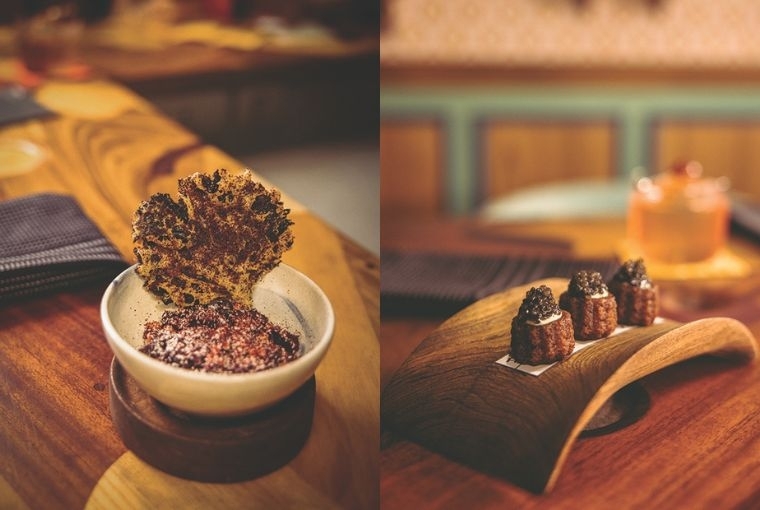
These clever, referential bites — much like the cocktails that come before — are delivered with the kind of animated enthusiasm Hussain carries both in his food and in the way he describes it. That mix of precision and play, of method and mischief, conveniently — or not — leads to what’s perhaps his most talked-about dish to date: Bugs Bunny.
Here, a humble jowar flatbread is the parcel for a tender but tenacious rabbit kebab, dressed in kosho — a sauce that is undoubtedly Japanese, but Indian, of course, with the addition of amla. If the bunny isn’t enough, the team will cheekily ask, ‘Can I bug you?’ as they serve up a topping of crunchy red weaver ants from Odisha. Diners should not be wary, they really just serve as a crunchy topping.
The uninhibited agency continues with strips of cuttlefish acting as the stand-in for that classic South Indian comfort of kothu parotta. Served in a ceramic petal bowl with a whimsical gold spoon, it’s a treasure hunt that makes one think about how that familiar flavor is tex- turally reimagined.
It is during this course when the rustic ice shaver makes itself useful. Previously serving as window decor, the crank is now in a full action, releasing a smoky cloud behind the counter.
Like many other parts of the dinner party, the team draws diners in with their insider jokes. This time the rib is that Hussain went to Thailand for a research trip and all he brought back was a salad. In this case, the traditional papaya version takes on the mazza of mango and passion- fruit with the sophistication of sorbet — a palate cleanser disguised as a punchline.
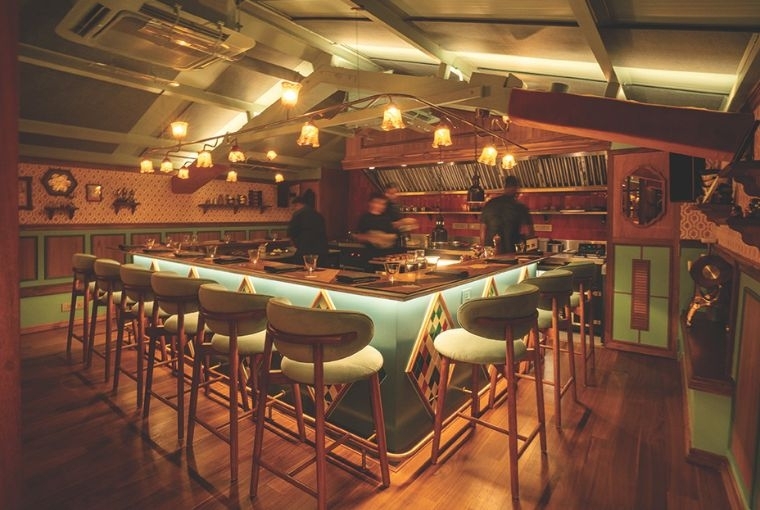
By this point in the meal - maybe before - it’s hard to keep track, there are no strangers at the table.
A couple sharing an intimate anniversary celebration are now in a full on three-way conversation with the single diner to the right, while the four college buddies and their friends are exchanging anecdotes with the one international pop star who’s made her way in. Hussain is pouring someone’s soup course while Madhusudhan, with his twenty four karat smile, is serving shots out of a Papa’s branded hip flask.
Paired with the easygoing environment, perhaps it’s Hussain’s pie dish that most clearly culminates the concept at Papa’s. Presented whole at first, like a classic British Wellington, a slice arrives on a boldly nostalgic flower-rimmed plate. Layers of flaky but firm pastry, tender lamb and spinach are served over a nihari that tastes as though it were lovingly cooked by someone’s mother. You could say that it was. The recipe belongs to Hussain’s mom, who pushed him to start cooking in the first place. Topped off with a golden bheja fry pakora, the dish is indulgent comfort at its best.
The meal rounds off with a duo of desserts that echo Papa’s sense of balance — savoury and sweet, memory and mischief. A blue cheese and honey sandwich pays homage to the bakery that once occupied this very space. The second is a cheeky send-up: wafer-thin potato chips served with lemon cream and truffle, a nod to the iconic combo of French fries and ice cream. By the time the final dish is cleared, it’s less of a conclusion than a shift in pace. The conversation doesn’t end; it lingers — just like one does at a friend’s place.
It’s not just the food, plated with colloquial confidence or the space, designed to disarm. It’s the presence of Hussain himself — moving from counter to cocktail, punchline to plating — with the same wide-eyed energy that brought him here in the first place.
Ultimately, Papa’s is a culmination of his journey — with gratitude for his mentor, ‘Chef Floyd’s two greatest pas- sions were bread and fine dining,’ Hussain says. ‘With Veronica’s downstairs and Papa’s upstairs, we’ve honored both.’
In a moment when Indian dining is reaching new heights of precision and polish, Papa’s offers something just as ambitious: ease. The kind that invites you in rather than showing off. Here, technique is simply a tool.
It is here, afterall, where Hussain is having his most fun. Along with anyone else — team member or guest — who’s lucky enough to join him.
Words Gauri Sarin
12. 07. 2025
